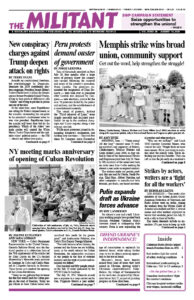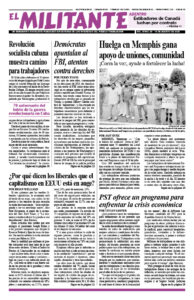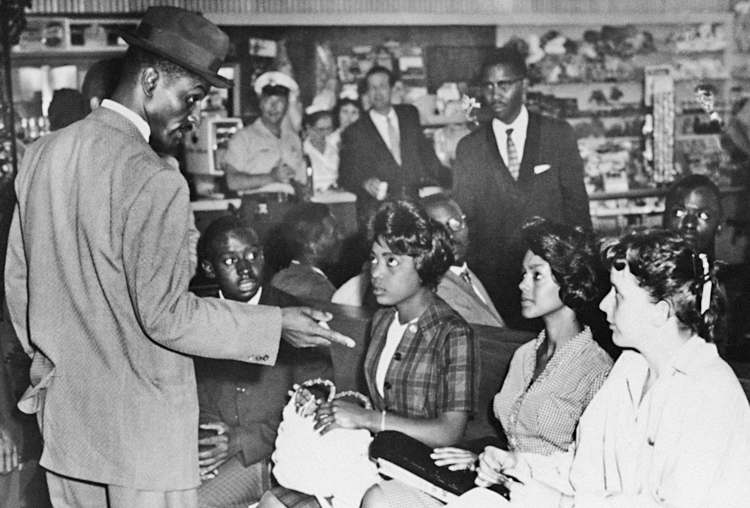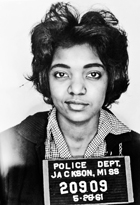The 1961 Freedom Rides were one of the watershed events in the Black-led working-class fight to overthrow Jim Crow segregation that changed social relations in the U.S. forever. Among those fearless, determined fighters involved in this moment in history was Catherine Burks-Brooks, who died July 3 at age 83.
Despite U.S. Supreme Court rulings in 1946 and 1960 that outlawed segregation in interstate travel, state officials and racist thugs across the South made sure they were ignored. In response to a call by the Congress of Racial Equality, volunteers set out from Washington, D.C., on Greyhound and Trailways buses May 4, 1961, with the goal of reaching New Orleans, desegregating bus station facilities all along the way.
They were met by cop and Klan violence. In Anniston, Alabama, a mob of white supremacists halted the Greyhound bus May 14, pelted it with rocks and bricks, smashed windows, slashed tires and lobbed a firebomb into the bus. The mob unsuccessfully tried to kill the Freedom Riders by blocking them from getting off the burning bus.
A few hours later, Freedom Riders on the Trailways bus were brutally beaten after they entered a whites-only waiting room at the bus terminal in Birmingham, Alabama. Police Chief Eugene “Bull” Connor arranged with local Klan leaders that police would stay away for 15 minutes, making time for the attack. Upon hearing of the assault, Rev. Fred Shuttlesworth led a force of civil rights fighters to free the Freedom Riders. In response to these assaults, CORE called for a halt to the rides.
But a group of students in Nashville, Tennessee, thought otherwise, including Diane Nash, one of the founders of the Student Nonviolent Coordinating Committee, and 21-year-old Catherine Burks, then a senior at Tennessee State University.
Burks, Paul Brooks, her husband-to-be, and eight other students left Nashville by bus May 17. At Birmingham city limits the police stopped the bus. Connor came aboard and ordered Brooks, who was Black, to stop sitting next to white student James Zwerg, saying it violated Alabama’s segregation laws. Brooks refused and both students were arrested. The other Freedom Riders were all thrown in jail.
That night Connor put some of the arrested students in police cars and said they were taking them back to Nashville. Burks-Brooks, sitting next to Connor in the front seat, got into a lively discussion with him. Connor spoke about his support for South Carolina Gov. Strom Thurmond, who led a walkout at the 1948 Democratic national convention to set up the segregationist States Rights Party. “Now, you know y’all were wrong,” she told him. She also invited Connor to continue the discussion over breakfast when they got to Nashville. He accepted, but never intended to do so.
‘We’ll be back by high noon!’
When they got to the isolated small town of Ardmore, on the Tennessee state line, Connor ordered the students to get out. “I couldn’t let old Bull have the last word,” she told the Tennessean in 2013. “I told the Bull, I hollered it out, that we would see him back in Birmingham by high noon!” And they were back there later that day.
Connor said there was a train station in the distance, but it was a shuttered warehouse. In the middle of the night the group got help from a Black family living nearby and phoned the Freedom Ride coordinator in Nashville, who organized a car to come get them and race back to Birmingham, watching out for the Klan all the way. As they neared the city, they stopped at Shuttlesworth’s to consult, then went to the bus station.
Burks-Brooks took part in two more Freedom Rides that spring, from Birmingham to Montgomery, Alabama, and from Montgomery to Jackson, Mississippi, where she and other Freedom Riders were arrested, convicted and tossed into the notorious Parchman state penitentiary.
With the Freedom Rides shining an international spotlight on American segregation, the John F. Kennedy administration called for the students to stop and “cool off.” CORE and SNCC leaders refused, as hundreds of volunteers joined in ride after ride that summer.
On to Monroe, North Carolina
After being released from Parchman, Freedom Riders responded to an appeal from Robert F. Williams, president of the NAACP chapter in Monroe, North Carolina, to come and join protests against segregation and Klan violence, including death threats against him. Twenty-two were there in mid-August.
Williams led a fight against the city’s segregated public accommodations, for equal employment opportunities and against attacks by racist thugs and cops. A former auto worker in Detroit and army veteran, Williams organized armed self-defense, setting up a rifle club to defend Blacks against all comers. He was framed up a few weeks after the Freedom Riders arrived on trumped-up charges of kidnapping, fleeing overseas for a number of years. The charges were later dropped.
Among Freedom Riders coming to Monroe were James Forman, executive director of recently formed SNCC. Paul Brooks was another, who was joined by Burks-Brooks, and they stayed at Williams’ home after getting married in South Carolina.
Joining pickets on the streets in Monroe, Freedom Riders faced threats and attacks by the Klan and city authorities.
Ken Shilman, a Freedom Rider who like Burks-Brooks had been incarcerated in Parchman, was arrested again in Monroe. In response to the brutal beating of Freedom Rider Richard Griswold in a nearby cell, Shilman yelled at the top of his lungs to get it stopped, saving his life. Shilman, then 18, would become a national leader of the Young Socialist Alliance and Socialist Workers Party.
For joining the Freedom Rides, Burks-Brooks and 12 others were expelled from Tennessee State University, but they fought back and got their degrees in the fall.
Throughout her life, Burks-Brooks took every opportunity to speak about her experiences as a Freedom Rider. “A glorious time to be alive,” she would say.
The actions by this fearless generation of youth — followed by the 1963 Battle of Birmingham and 1965 voting rights battle and march in Selma and Montgomery — transformed their lives, the potential to forge working-class unity and prospects for the U.S. class struggle.



